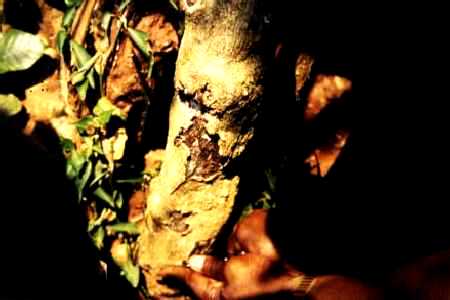(Fusarium xylarioides)
Credits: Biovision-Infonet

(c) Courtesy EcoPort FAO in collaboration with CAB International
Indicative symptoms include wilting, chlorosis and defoliation of the aerial parts of the crop, and numerous vertical and spiral cracks in the bark of the trunk. Inspection under the bark, especially around the collar, will reveal characteristic blue-black streaks in the wood. Fungal fruiting bodies (stromata) producing spores can be observed in the bark. Infected berries turn red and appear to ripen early. Seed infection causes blue-black discolouration of the parchment and silver skin. Spores are spread by wind, rain and through human activities (harvesting, pruning etc.). The pathogen can penetrate through wounds so any agency causing wounds will aid the spread of the fungus. Insects may also spread the disease from tree to tree.
Seed from infected berries may contain the pathogen and seed-borne infection is one way in which the disease is spread. Seedborne infection is responsible for seedling blight where the cotyledons fail to unfold, the stem becomes necrotic and the seedling dies. Infected seedlings often survive the nursery stage and later develop collar rot.
The fungus is soil-inhabiting and can penetrate through wounds in the aerial parts or superficial roots. The incubation period from first symptoms to death of the tree varies from days in young plants to 8 months in trees more than 10 years old, although most affected trees die 2-3 months after initial symptoms are observed.
What to do:
- The use of disease-free seed is advised (from areas where the disease is not present).
- Frequent inspection of the crop, along with burning infected material and spraying the soil surface with 2.5% copper sulphate has been advocated as an effective control measure.
- Replanting should not be done until 6 months after uprooting infected trees to allow the disease in the soil to decline.